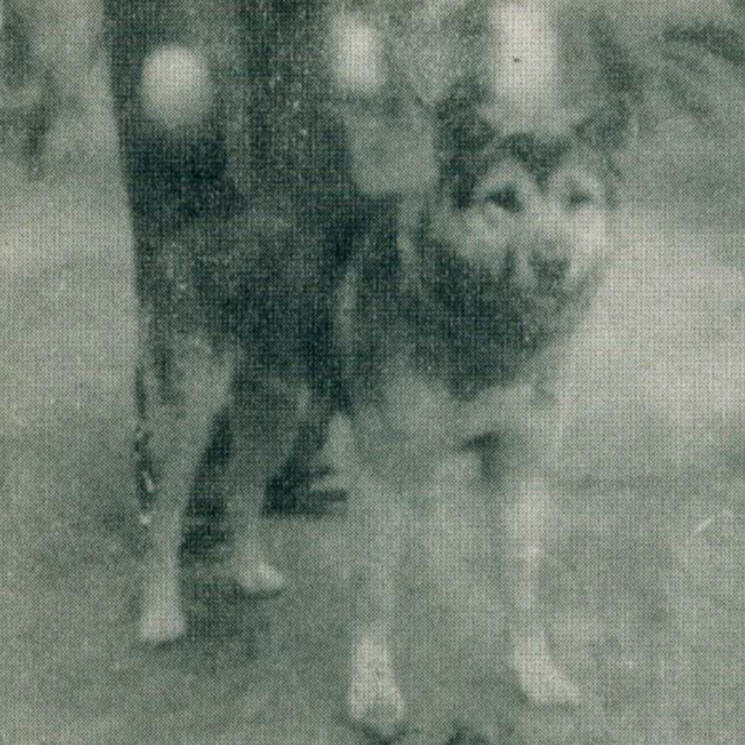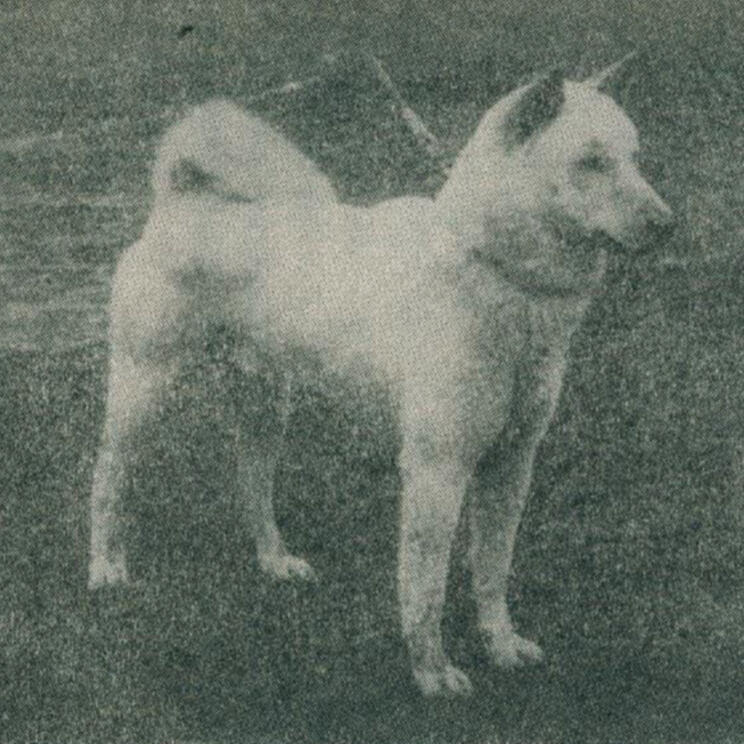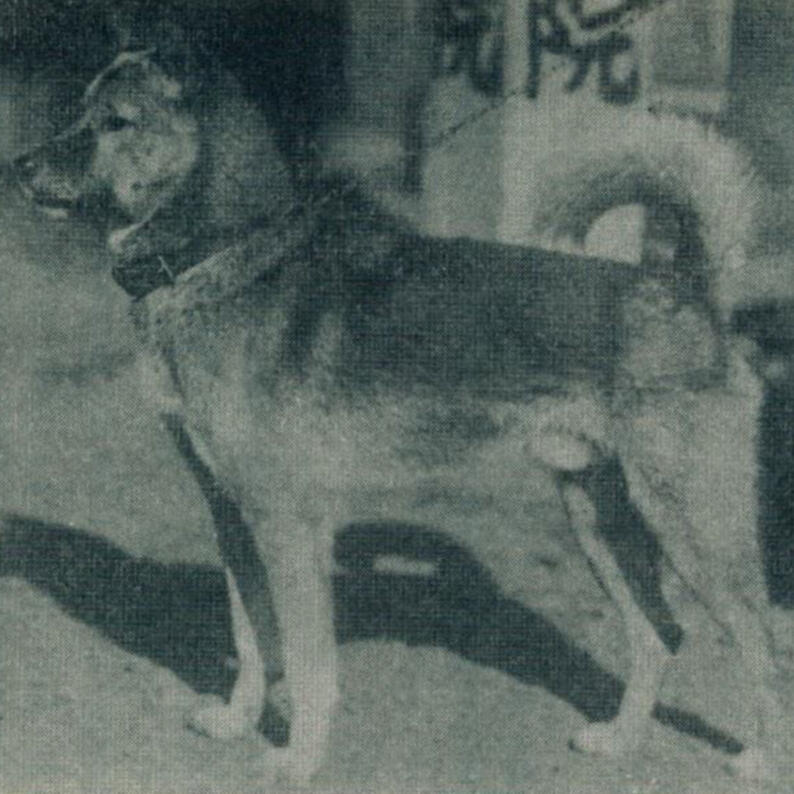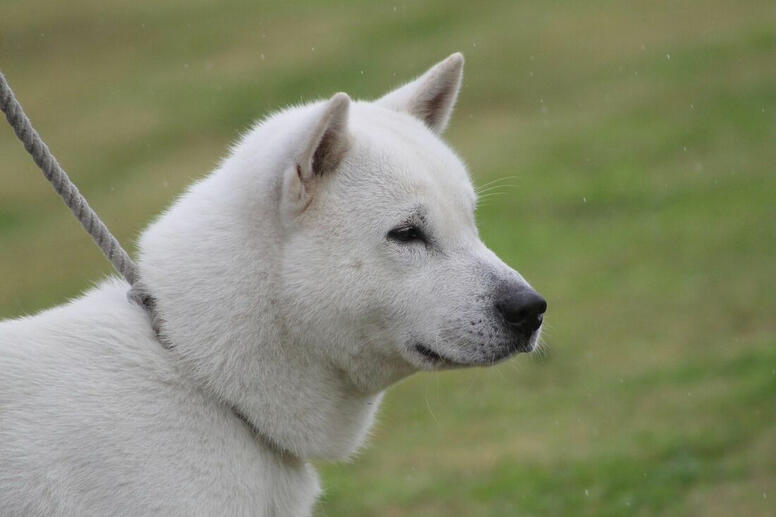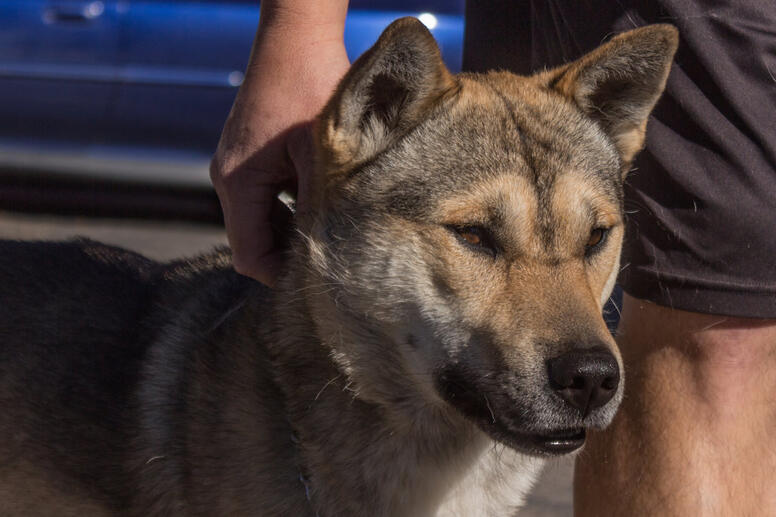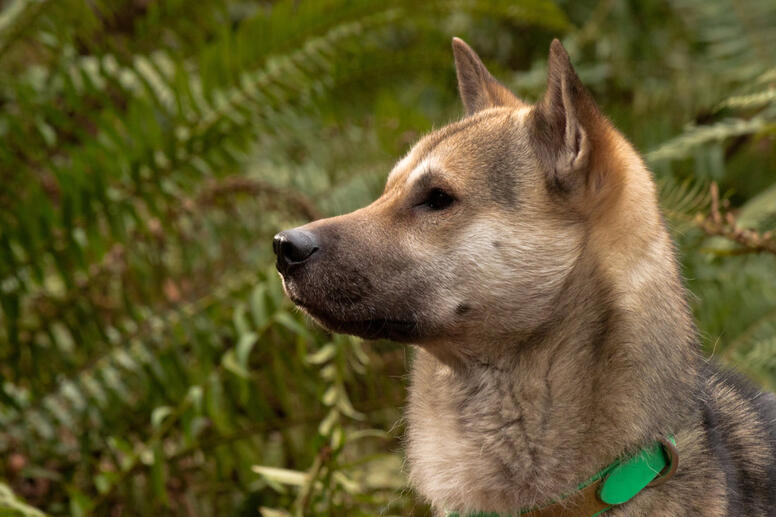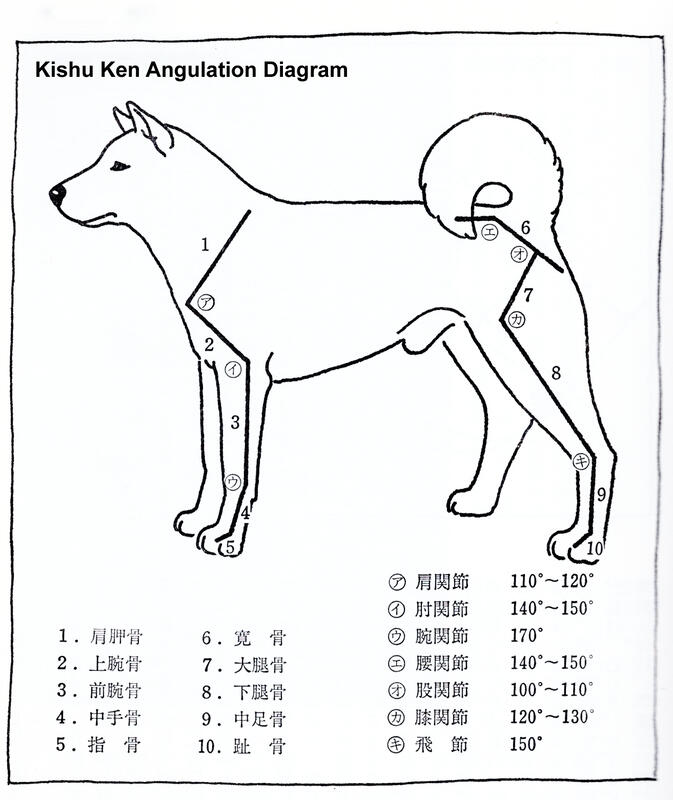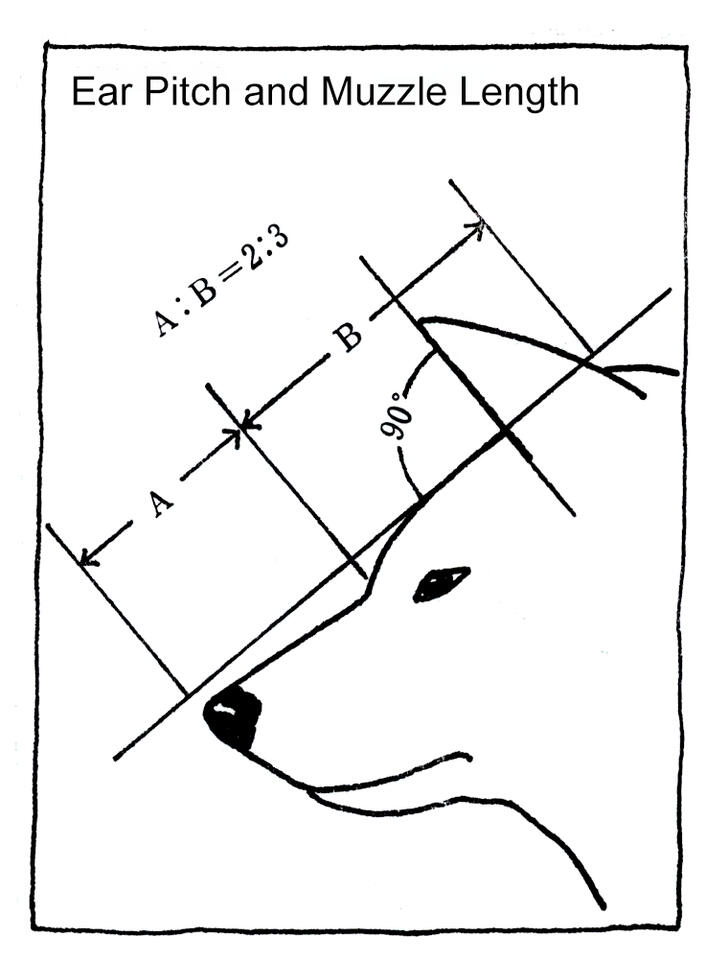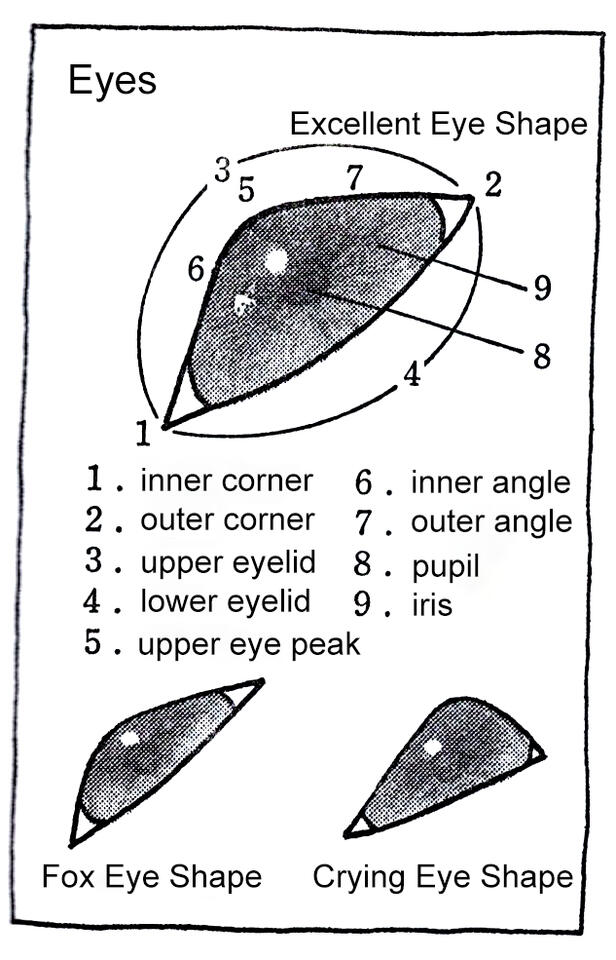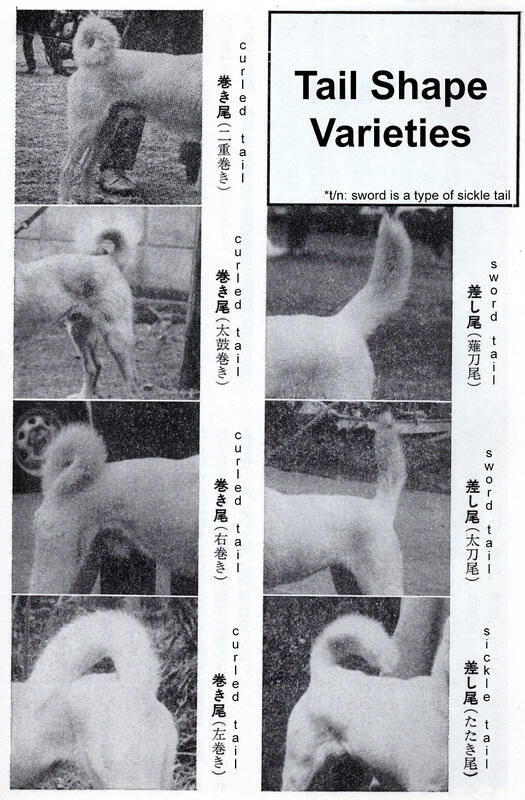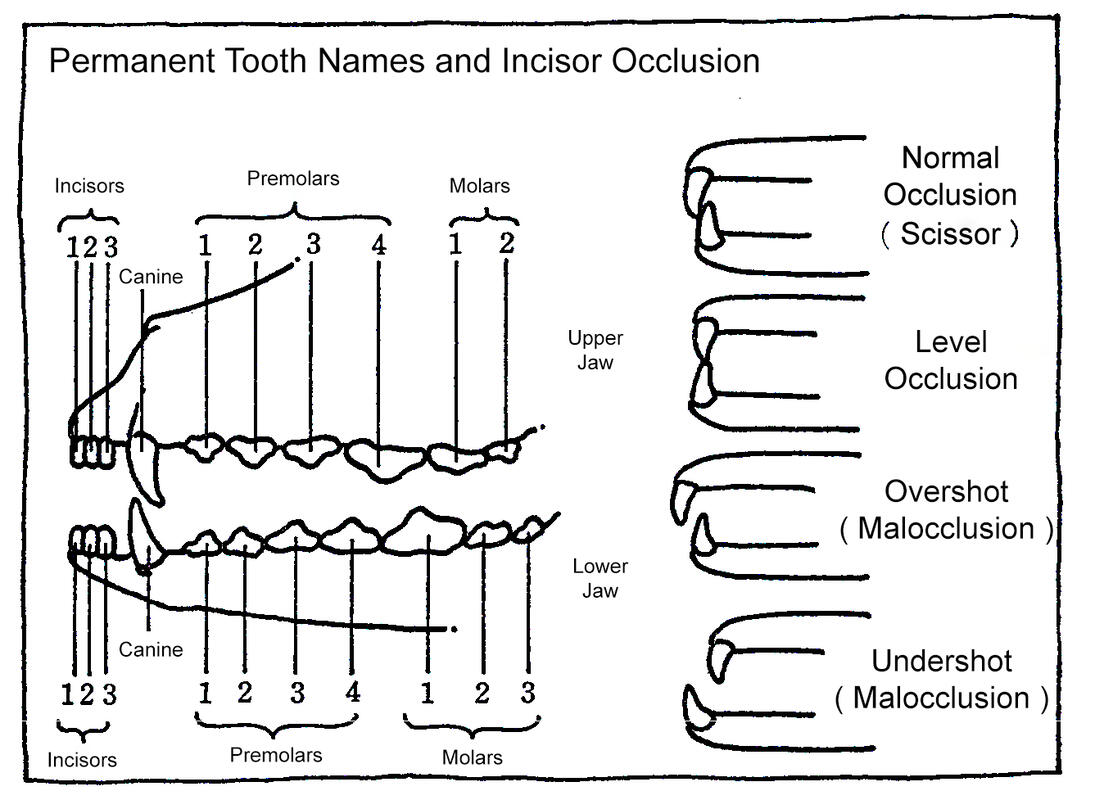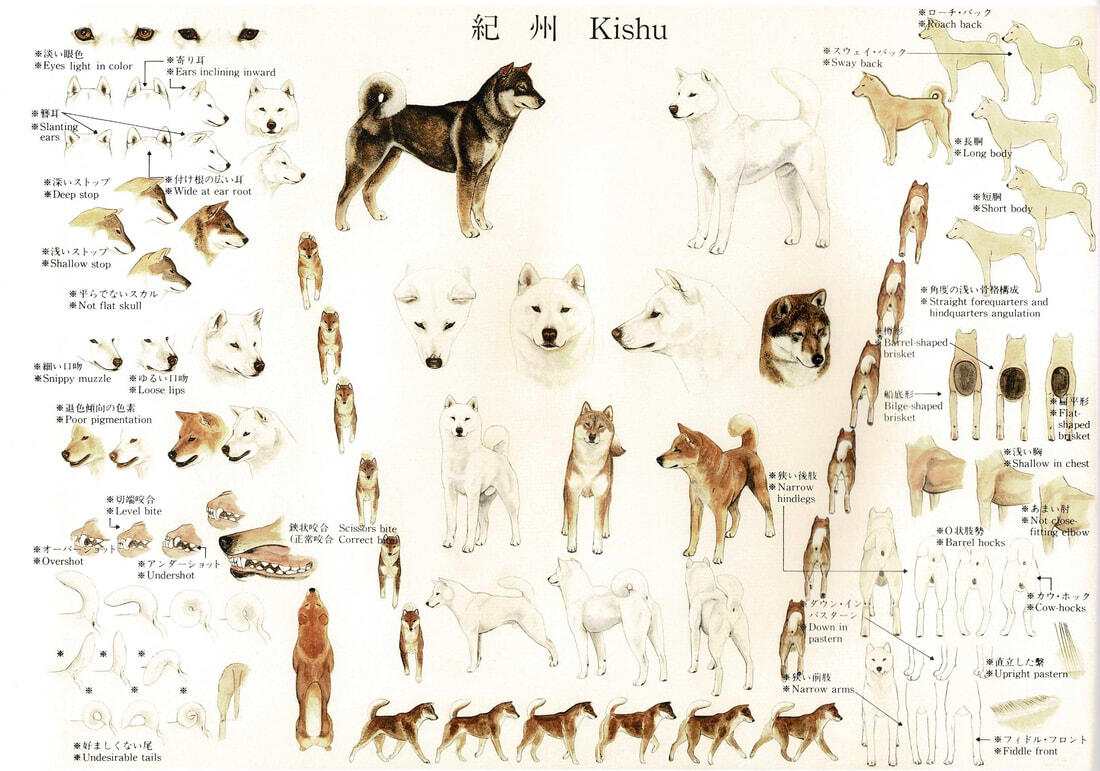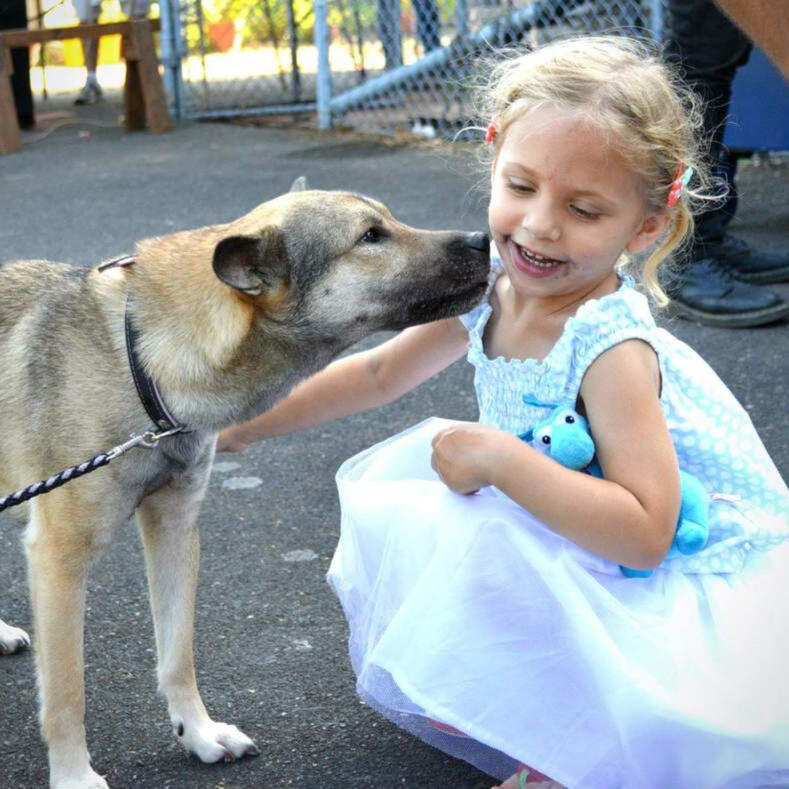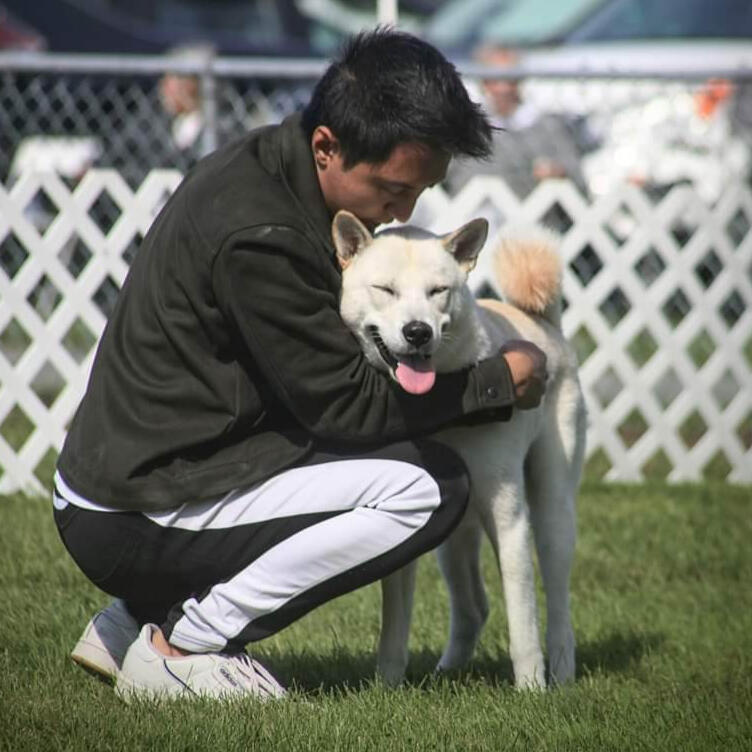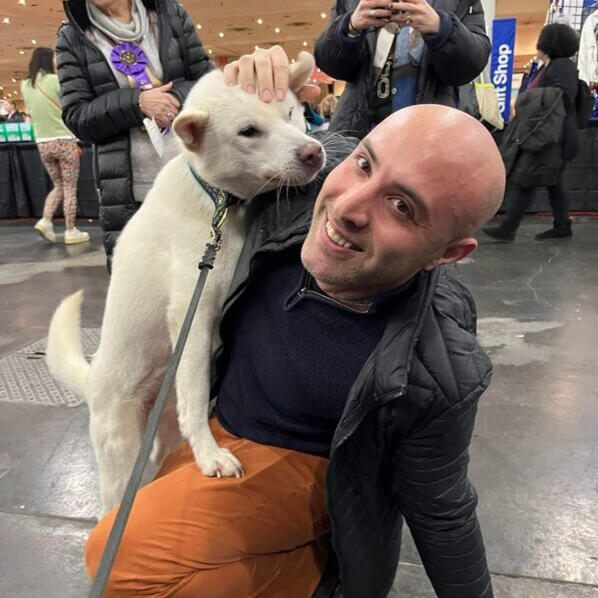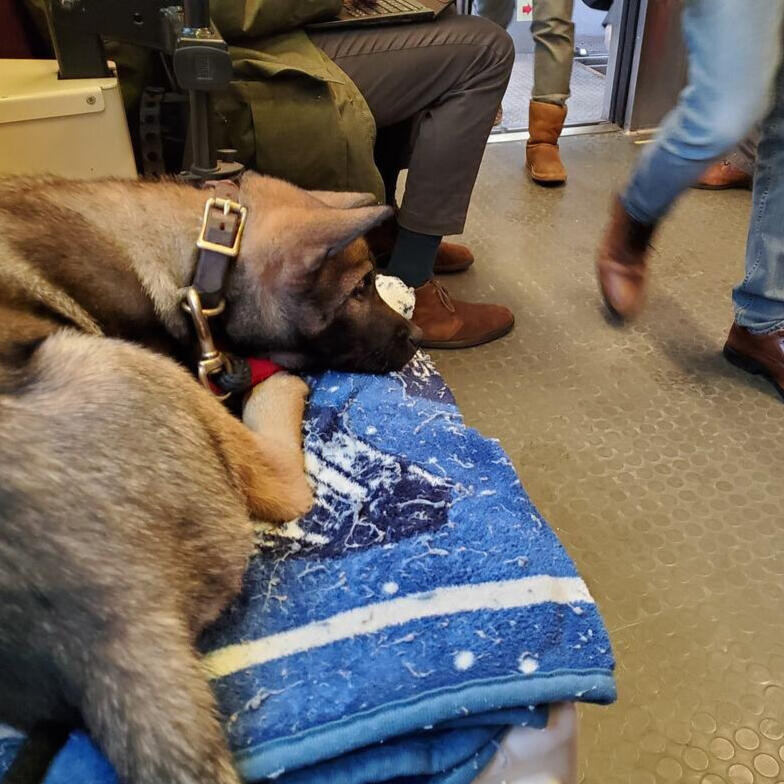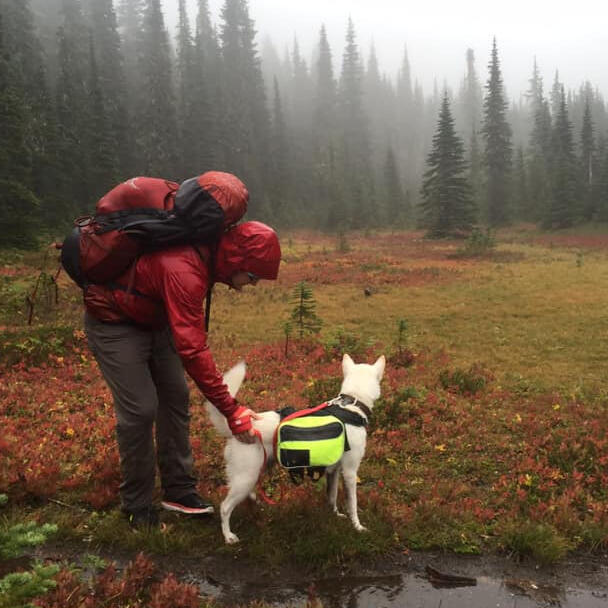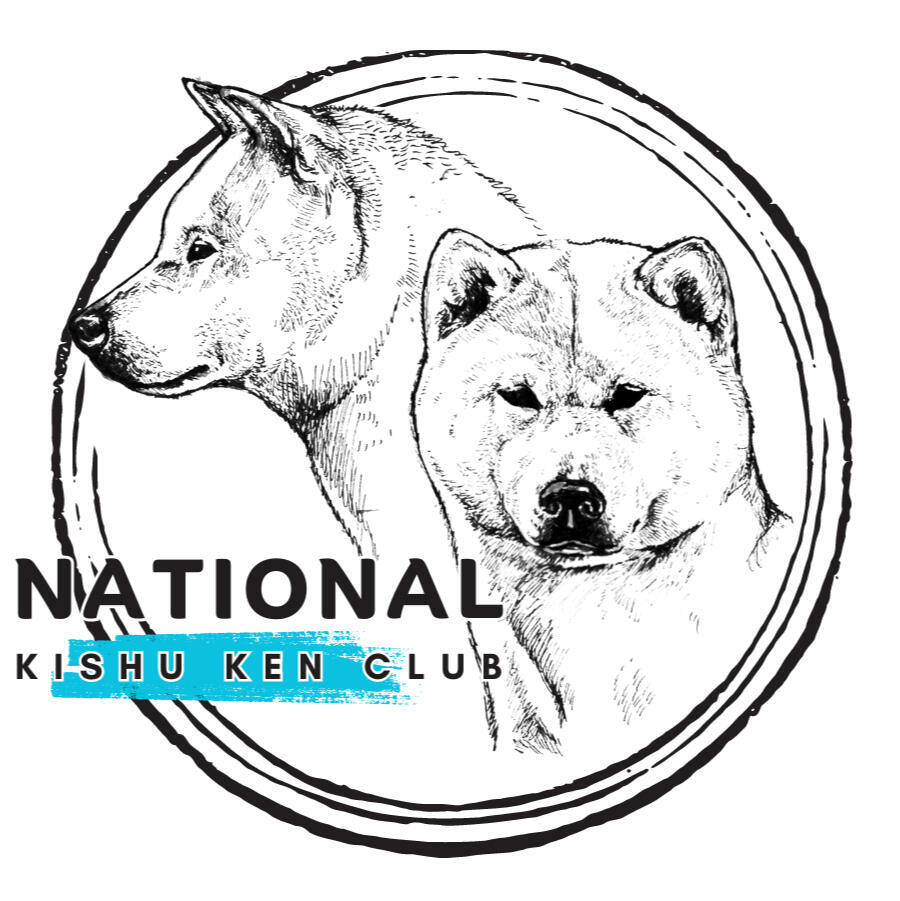
The AKC National Parent Club
The National Kishu Ken Club (NAKC) is a national breed club in the USA devoted to the preservation of the Japanese Kishu dog and upholding the Nihon Ken Hozonkai (NIPPO) standard in the American Kennel Club (AKC.)Our mission is to preserve and promote the diversity present in the breed, to foster community between Kishu owners and enthusiasts, and to bring education to the community outside of the breed in order to maintain Kishu for future generations.
The National Kishu Ken Club was formed to bring Kishu Ken owners and enthusiasts in the USA together to help promote, preserve, and support the country of origin standard and uphold these honored standards within the American Kennel Club.As an internationally recognized breed, the Kishu Ken has a handful of written standards from around the world. The Nihon Ken Hozonkai (NIPPO) is the Kishu's primary club and registering body in the country of origin and the first to write a standard for the breed back in 1934. The Kishu is recognized internationally by the Fédération Cynologique Internationale (FCI) and those clubs that participate. In North America, the Kishu also has a United Kennel Club (UKC) standard. Kishu are, additionally, permitted in the Foundation Stock Service (FSS) - a registration service of the American Kennel Club (AKC) working on their way to recognition.
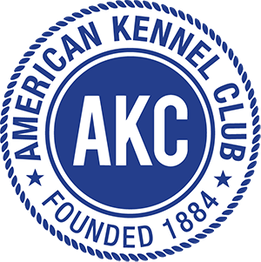
The Kishu Ken
Japan's Premier Aboriginal Hound
The Kishu Ken is a large game hound from the Kii Peninsula, where modern day Wakayama and Mie prefectures sit. The breed has a strong association with the Japanese wolf, from which it is said to be descended. In fact, according to some, the Kishu has a handful of physiological traits that are remnant of the wolf, from their webbed feet and rear dew claws ("wolf claw") that sometimes pop up, to the robustness of their teeth. Paying homage to this, many modern Kishu have names which are inspired by the wolf. A common sight is the -rou (郎) ending common on boys names being replaced with the -rou (狼) pronunciation of the wolf kanji.The Kishu Ken as a breed is fairly young - less than 100 years old - and was first standardized in 1934 through the Nihon Ken Hozonkai (NIPPO.) The breed name, "Kishu Ken" or "Kishukn" is used over the name "Kishu Inu" due to grammar practices: "Kishu" (紀州) is read using the "on" pronunciation of the kanji, so "ken" should be used as the "on" pronunciation of the kanji for dog (犬.) The names "Kishu Inu" and "Kishu dog" (or, simply, "Kishu") are sometimes used interchangeably outside of Japan when speaking about the same breed due to transliteration choice or translation error.The Kishu Ken was named and developed out of those wolf-descended hunting dogs of the Kii peninsula and refined from there. In early development, the Kishu Ken had many coat colors at a frequency similar to their sibling-breed, the Shikoku Ken. However, popular sire lines that emerged in the late 1950s and 60s slowly transformed the breed into the modern, white-coated dog. Until 1980, the Kishu Ken was shown as a regional variant of the medium sized Nihonken (Japanese dog) competing for a single award. In 1981 the 4 medium sized Nihonken were able to receive their own awards.

Naru go 奈留号

Dainiri go 弟二理号

Suzukagorou go 鈴鹿五郎号
The Kishu has, in the past, been called by other names based on the area where the founding dogs came from; the Kumano Ken and Taichi Ken are among these historic names. Today, all registered dogs are recognized as "Kishu Ken." Like the other Japanese breeds, the Kishu Ken's population suffered in the wake of World War II but were mostly spared due to the mountainous and isolated region they originate from and the hunters who valued them.Outside of Japan, the Kishu Ken has been recognized by the FCI since 1982, by the UKC since 2006, and by the AKC Foundation Stock Service since 2005. They have been regularly bred outside of Japan since 1993, first introduced to the USA and then, later, to the Netherlands.The Kishu was once one of the most populous of the medium-sized breeds in Japan but has recently taken a swift dive toward extinction. This can be attributed to the Kishu Ken's energy and hunting ability which sometimes does not combine with modern Japanese living in small apartments. Despite this, the Kishu Ken is the most common native purebred dog used for boar hunting in Japan. Their numbers outside of Japan remain slim and the sharp decline they've seen in the last decades threatens them with extinction.
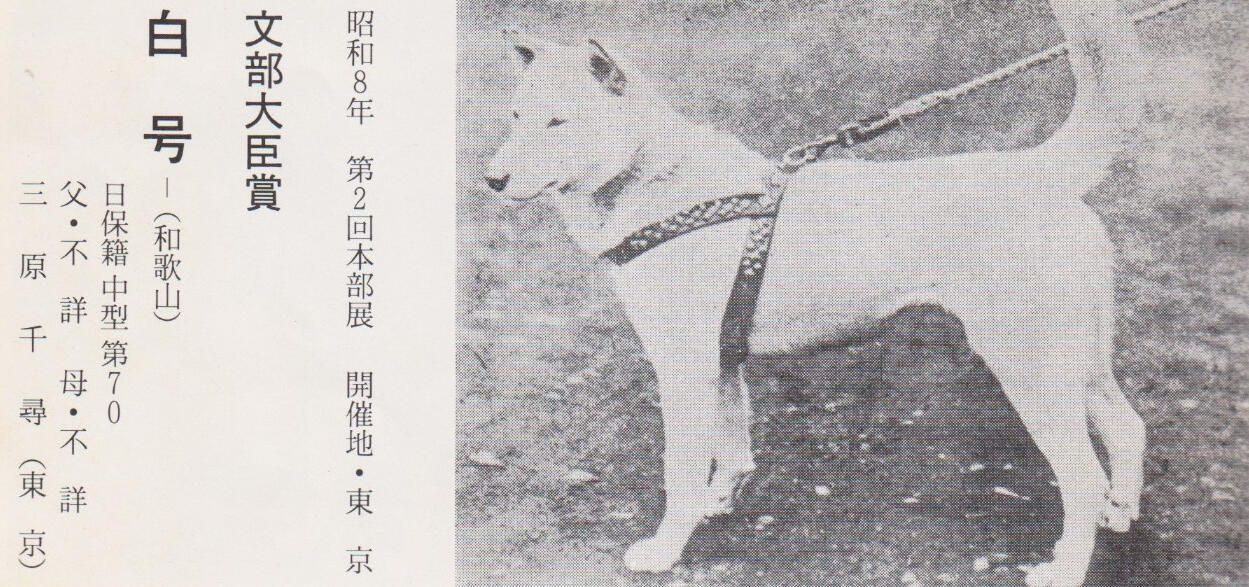
History in the USA
COMING TO THE USA & THE NATIONAL KISHU KEN CLUB
The Kishu Ken is believed to have been first introduced to the USA in the late 1960s. Newspaper articles and published ads show a history of the Kishu Ken being imported from Japan bred in the states of California and Massachusetts since 1971. Kishu Ken continued to be imported through the 1980s and 1990s, finding minor footholds in these states and Washington state additionally. Early lines and breeders appear to have dissolved before passing on their breeding stock, kennels, or experience.1The first known NIPPO knnels in the USA, Sanfuran and Beikoku Kinokawa, both operated out of the Bay area of California. The first long-time established kennel in the United States imported additional dogs from Japan and obtained dogs from other early breeders in the early 2000s and increased the population in the USA via pet dogs. However, this breeder made no effort to establish the breed's health or health test breeding stock and created their own standard for the breed, which aided in misinformation and division between the dogs of Japan and the USA.In the 2010s there was another push for NIPPO breeders in the USA: Sagami no Roushya, Akiyama no Roushya, and Hakuzan Ryousou. This eventually formed the basis for the National Kishu Ken Club.The National Kishu Ken Club was formed in 2015 to bring Kishu Ken owners and enthusiasts in the USA together to help promote, preserve, and support the country of origin standard and uphold these honored standards within the American Kennel Club. The AKC has accepted the Kishu Ken into the Foundation Stock serviceAs an internationally recognized breed, the Kishu Ken has a handful of written standards from around the world. The Nihon Ken Hozonkai (NIPPO) is the Kishu's primary club and registering body in the country of origin and the first to write a standard for the breed back in 1934. The Kishu is recognized internationally by the Fédération Cynologique Internationale (FCI) and those clubs that participate. In North America, the Kishu also has a United Kennel Club (UKC) standard. Kishu are, additionally, permitted in the Foundation Stock Service (FSS) - a registration service of the American Kennel Club (AKC) working on their way to recognition.
history of imported dogs & foundation dogs
1. If you or anyone you know is aware of thes early dogs, breeders, or lines, please contact us - the club is very interested in hearing the ever-evolving story of the Kishu Ken in the United States!
Here you can find a known list of all imported dogs to the USA. Many of these dogs are directly related to one another or related within one or two steps. It is important when looking at the list of imported dogs not to directly relate number of dogs imported from outside the USA to available genepool. If you are aware of a dog imported to the USA not on this list, please let the club know and we may add them to the list.It was once erroneously printed that Kishu Ken were not able to be exported from Japan. This is not true and Kishu Ken breeders in Japan are eager to share their dogs with the USA. Importing a show and breeding quality Kishu Ken who is able to be competitive in NIPPO shows in Japan is another matter, and can explain some of the varied appearance of Kishu Ken outside of Japan.
| Registered Name | DOB | Color | Breeder | Sponsor |
|---|---|---|---|---|
| Misuzu go Maruoka sou [JP] | 10/06/1991 | White | [unknown] | Carleen Newman |
| Dairyu go Toyohashi Fujiwara Kensha [JP] | 10/08/1991 | White | [unknown] | Carleen Newman |
| Norihime go Kishuu Yoshitaka sou [JP] | 2002 | White | Yoshitaka Nishikawa | Risa Kasuya |
| Kana go Misato Ueno sou [JP] | 09/03/2003 | White | Tadashi Ueno | Carleen Newman |
| Tesshu go Hidaka Yamada sou [JP] | 2003 | White | [unknown] | Risa Kasuya |
| Negoro no Ai go Garou sou [JP] | 2005 | White | [unknown] | Yoshiaki Ajari |
| Zushuu no Tarou go Tourou sou [JP] | 09/26/2009 | White | Kazunori Hanaoka | Gen Murofushi |
| Yawata no Tsukihime go Ichikawa Kinofuji [JP] | 10/21/2010 | White | Kondo | Gen Murofushi |
| Oosaka no Sekihime go Kishuu Yoshitaka sou [JP] | 10/25/2011 | Red Sesame | Yoshitaka Nishikawa | Brad & Jen Anderson |
| Kamishiro no Ginshun go Gunrou Towa sou [JP] | 03/09/2013 | White | [unknown] | Carleen Newman |
| Houshunme go Gunrou Towa sou [JP] | 02/24/2014 | Sesame | [unknown] | Brad & Jen Anderson |
| Inaho no Haru go Bousou Yawara sou [JP] | 09/13/2015 | White | Yoshito Watanabe | Brad & Jen Anderson |
| Gomataro go Bousou Yawara sou [JP] | 12/17/2015 | Sesame | Yoshito Watanabe | C.J. McCammon |
| Tsuyahime go Aiki Kensha [JP] | 08/30/2016 | Sesame | [unknown] | Brad & Jen Anderson |
| Seihoume go Hakushuu Daizan sou [JP] | 10/07/2016 | White | Susumu Okada | Brad & Jen Anderson, C.J. McCammon |
| Jikino Kensha no Nami no Aima go [FI] | 10/12/2017 | White | Riina Haapakallio | C.J. McCammon |
| Sakura no Bunta go Himeharu sou [JP] | 05/09/2018 | White | Masayuki Suzuki | Private Owner |
| Yoshimi Trump Hunter [UA] | 07/19/2020 | White | Julia Kovgan | C.J. McCammon, Kristina Arthmann |
| Sakura no Shin go Himeharusou [JP] | 12/19/2020 | White | Masayuki Suzuki | Private Owner |
| Katsuichime go Tomoe [JP] | 01/18/2021 | White | Eiji Yokota | C.J. McCammon, Brittany Wall |
| Katsusaburou go Tomoe [JP] | 01/18/2021 | White | Eiji Yokota | C.J. McCammon, Kristina Arthmann |
| Fumi Damu Kara [CZ] | 12/08/2022 | White | Nikola Matoulkova | Carleen Newman |
| Souma go Kenyuan [JP] | 12/22/2022 | White | Maiko Morimoto | Kristina Arthmann |
| Kouunme go Kinokatsu sou [JP] | 08/06/2023 | Sesame | Katsuharu Soumiya | C.J. McCammon, Alexis Amerosa |
| Yukiguni no Dosei no Titan go [FI] | 10/04/2023 | White | Katri Marttila | Private Owner |
| Kasuga go Nakaryuufuusou [JP] | 01/24/2024 | White | Emiko Okazaki | C.J. McCammon, Private Owner |
| Yuki no Asahihime go Nakaryuufuusou [JP] | 01/24/2024 | White | Emiko Okazaki | C.J. McCammon |
| Neo go Kenyuan [JP] | 02/22/2024 | White | Maiko Morimoto | C. J. McCammon, Katri Marttila |
NAKC Health Statement
While the Kishu Ken is a generally healthy breed there are some known health concerns. The majority of individuals with health issues (by owner report) are generally troubled by minor to moderate food and environmental allergies. Less common than allergies are reports of hypothyroidism, Addison's disease, entropion, and cancers that are more likely to appear in older and elderly dogs. Autoimmune conditions such as lupus that may result in inflammation and/or sores have also been observed.One of the goals of the club is to promote the breeding of healthy, active Kishu Ken and be as transparent as possible about health concerns. We provide data and recommendation where possible on what breeders and owners can do to mitigate and combat them while also maintaining population size and diversity.Maintaining genetic diversity and health is among the National Kishu Club’s mission statement. The National Kishu Club recognizes that it is not in the best interest of the genepool to base an individual dog’s place in the genepool and breeding purely on the black and white meter of health testing. Health testing should be used first and foremost to gain knowledge, but health and diversity must always be in balance.
Article I: Health testing
Overview. The Kishu Ken is a generally healthy breed with little current evidence of joint or other physical deformities. Breed health issues are few, but exist mostly in the realm of the autoimmune system, eyes, and skin health. Breed-specific illnesses and other deformities that appear in the breed will be listed in this document.
Regulation. The National Kishu Club does not currently have a health testing policy that requires breeders perform testing before breeding. However, the National Kishu Club demands that breeders are transparent and open with their puppy buyers about breed health and give full disclosure on what is known about their stock to prospective puppy homes. Breeders who are not open, honest, and transparent with puppy buyers may be found to be in breach of the Code of Ethics, Bylaws, and Constitution.
Recommended tests. Genetic screening (Optimal Selection/My Dog DNA, Embark) (OFA DNA repository CHIC recommended), Thyroid evaluation (OFA) (CHIC required), Dentition (OFA) (CHIC required), Eye evaluation (OFA/CERF) (CHIC required)
Additional tests. Elbow evaluation (OFA) (CHIC optional), Hip evaluation (OFA, PennHip) (CHIC optional), Knee evaluation (OFA) (CHIC optional), Cardiac Auscultation (OFA), Spine evaluation (OFA)
Article II: Autoimmune Health
Allergies. Current data (in an owner-reported survey) suggests that as much as 30% of Kishu Ken have experienced inflammation of the skin and 40% of Kishu Ken have experienced itching in patterned behavior. Allergies are generally associated with depressed immune health and can be strongly correlated with limited diversity in the breed. Allergies have complicated genetic and environmental factors, and it is not the statement of the National Kishu Club to expel dogs suffering from easily managed allergies from the genepool at this time. Allergy dogs should be intelligently paired to avoid inbreeding on any affected ancestors when possible, which may avoid allergies in future generations. Allergies generally have an adolescent and adult onset from 1-3 years of age.
Hypothyroidism is sometimes seen in Japanese dogs and the Kishu is not an exception. Hypothyroidism is most commonly caused by Autoimmune Thyroiditis, an autoimmune condition that can be screened for in parent dogs and has been discovered in the Kishu Ken. Autoimmune Thyroiditis is genetic. This is a recommended test for the Kishu Ken. Symptoms of hypothyroidism may not appear until after 5-6 years old when the thyroid fails in dogs with Autoimmune Thyroiditis, thus it is the position of the National Kishu Club to recommend testing for this illness with an OFA thyroid panel in breeding dogs. Some Kishu Ken may test as in the positive compensative state without being hypothyroid. At this time it has been observed that some of these dogs may test normally in the future while others will experience hypothyroidism and thyroid failure. It is recommended to retest breeding dogs every 2-3 years.
Addison’s Disease. The inheritance mode of Addison’s Disease is not clearly understood but, as a policy of caution, any dog suffering from a diagnosed autoimmune illness should be removed from prospective breeding. Addison’s disease may only be screened for in individuals at or after the onset of symptoms. Symptoms generally manifest in adult dogs 2 years of age to 6 years of age.
Systemic & Cutaneous Lupus Erythematosus. If your Kishu has severe allergy-like symptoms which may appear as sores on the nose and mouth, sores on the feet, hair loss in these areas, and severe reoccurring dermatitis, please speak to your veterinarian about SLE or CLE. There is no current preventative test for SLE or CLE in breeding dogs. Dogs with visible symptoms of SLE/CLE or with a diagnosis should not be used for breeding.
Article III: Eye Deformities
Persistent Pupillary Membrane or PPM is an uncommon Kishu Ken deformity of the eye. These are membranes that failed to disappear by 5 weeks of age, when nutrients stop being carried to the developing eye. These membranes generally cause no issue to the Kishu’s sight but can become problematic depending on location. PPM may be seen on a standard manual eye exam. The inheritance mode of PPM is not entirely understood, and it is not the policy of the NAKC to expel dogs exhibiting PPM from breeding due to its relatively benign nature. (This call is up to an individual breeder and what they feel comfortable producing.) However, PPM does appear generational in some pedigrees.
Posterior Suture Tip Opacities is a small opacity along the "seam" where the lens formed. This does not typically affect vision but may appear on an OFA evaluation for a dog. Out of an abundance of caution, it is recommended to breed such an affected dog to a clear/normal dog.
Entropion is a rare deformity of the eyelid in Kishu Ken where the eyelid rolls inward and scratches the eyeball, causing inflammation and conjunctivitis over time. Entropion almost always needs surgery to correct. This deformity is sometimes caused due to the shape of the Kishu’s eye (that of a tight triangle) and dogs diagnosed with entropion are not recommended to be used for breeding. Entropion is easily evaluated via a standard eye exam. This is a recommended exam for Kishu Ken.
Juvenile Cataracts are another rare eye condition in the Kishu Ken which does impact vision. Dogs who are affected by juvenile cataracts should not be bred. Due to inheritance modes presence in other breeds, dogs which produce juvenile cataracts should not be bred together again.
Article IV: Joint Deformities
Elbow deformities are among the most diagnosed joint deformities seen in Kishu Ken. Over the population of radiographed individuals this diagnosis is still rare. A type of elbow deformity called FCP (Fragmented Corornoid Process) has been diagnosed in Kishu Ken in the past. Elbow evaluations are among the National Kishu Club’s optional tests based on this data. Elbows may become a more pressing breed health concern with future data. This information may be seen via radiograph and evaluated through health databases such as the OFA.
Hip deformities are currently rare among Kishu Ken, and no Kishu Ken currently known has ever received a dysplastic rating when evaluated. The majority of evaluated Kishu Ken receive excellent or good (A/A) to fair (B/B) ratings in the OFA or FCI system when evaluated by radiograph. Because of this data, evaluation of the hips via radiograph should be a case by case basis, optional to the breeder or owner.
Knee deformities are likewise uncommon. This is an optional test that can be performed via articulation and/or radiograph, evaluated by the OFA.
Odd joint deformities are rarely seen, such as dysplasia of the joints of the toe. If a dog is excessively foot-shy or otherwise symptomatic, it is recommended they be screened or evaluated by a veterinarian.
Joint deformities are not always clearly heritable, nor do minor deformities impact the quality of life in a medium sized, athletic dog breed. The National Kishu Ken Club leaves final say up to the breeder to determine if a dog diagnosed with a deformity in the joints should be retained for breeding. All things equal with consideration to the infrequent appearance of joint deformities, when deciding between a dog with joint deformities or one that is deformity free, preference should be given to the healthy dog.
Article V: Growth Deformities
Dentition. A dog with genetically missing teeth is in conflict with the Kishu Ken standard where missing teeth are penalized. A count can be provided through the OFA and is recommended to be performed on a young adult. Good Kishu teeth should not fall out due to injury but may become chipped.
Malocclusion. Underbites or overbites are a developmental deformity that can be genetic. Dogs exhibiting malocclusions are disqualified from the conformation ring. As malocclusions may have a genetic component and may be indicative of a skeletal deformity, it is not recommended to breed dogs with malocclusions. Mandibular mesioclusion (underbites) have been observed. This is not likely to cause an impact on a dog’s quality of life in the Kishu Ken, and mandibular mesioclusions that have been seen are very minor.
Kinked tails. Kinked tails are sometimes observed in Kishu Ken through birth defect or breaks. Kinked tails are discouraged in the breed and disqualified in the show ring. This can be seen upon exam and does not impact the dog’s quality of life. Breeds with kinked tails can be prone to other spinal deformities and affected dogs may be radiographed for OFA spine out of an abundance of caution. At least one Kishu Ken with a severely life-affecting congenital spine deformity has been known at this time. The NAKC is reassessing need to add spine to CHIC requirements for breed health clearances.
Monorchidism is rare in the Kishu Ken but has been reported.
Kishu Ken Standard (Proposal)
I. General Appearance. The Kishu Ken is a large game hound used in the densely forested mountains of the Kii peninsula. They are spirited, alert, and rustic in appearance, with compact, but well-developed muscles. Kishu Ken are medium in size with erect ears, a tail held over the back, and a keen expression. Dogs are larger and visibly masculine with a stern and ready-for-anything posture. Bitches are smaller and impart the impression of grace and discernment. Honorable scars which impact the essential qualities of the Kishu Ken are to be evaluated by the judge who may determine the severity of the fault.II. Size, Proportion, Substance. Height is 20.5 inches for dogs and 19 inches for bitches. A deviation of 1.25 inches in either direction for both sexes is permitted. Proportions are very slightly longer than tall, at a ratio of 10:11. Bitches are very slightly longer than dogs. In both sexes, the Kishu Ken is well-muscled with moderate substance. Disqualification—Males over 22 inches or under 19 inches. Females over 20.5 inches or under 17.5 inches.
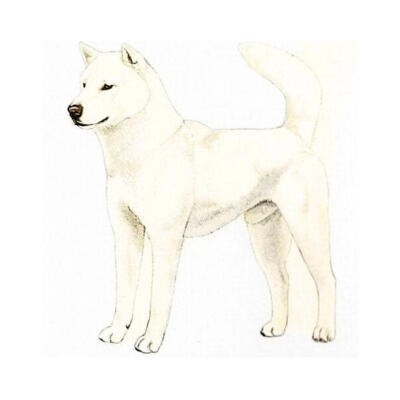
White | source: JKC Illustrated Standard

Black Sesame | source: JKC Illustrated Standard
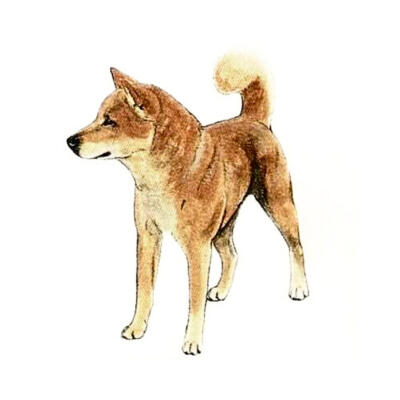
Red | source: JKC Illustrated Standard
III. Head
Expression is confident and intense. In males the expression is bold and sharp. In females the expression is somewhat kinder and appraising.
Eyes are triangular and very dark brown in color. The flesh of the eye rim is dark. Ears stand erect and hooded. The ears are inclined forward to follow the arch of the neck. Disqualification—Hanging or dropped ears.
Skull is broad and substantial, with a wide forehead. The skull is flat and extends behind the ears when viewed in profile.
Stop is moderate and has a slight furrow to the brow.
Muzzle is straight and firm. The shape resembles a thick wedge from the nose to the well-developed cheeks.
Nose is black. Faded black or flesh-colored noses are permitted in white dogs. Lips are tight and straight.
Bite is strong and substantial. Teeth come together in a scissor. Kishu Ken have a full set of healthy teeth. Broken or surgically removed teeth due to injury are not to be penalized. The tongue is pink. Severe Fault—Missing teeth. Disqualification—Malocclusion (underbite or overbite.)

ph: Alexis Amerosa, NIPPO Grand National

ph: C.J. McCammon, sesame hunting line dog with an intense expression

ph: Alexis Amerosa, NIPPO Grand National

ph: C.J. McCammon, sesame import (JP)
IV. Neck, Topline and Body
Neck is moderately thick and long. It is well-muscled and powerful.
Topline is straight from the back of the shoulder to the tail, and strong.
Body is athletic and muscular. The Kishu Ken are presented in fit condition for hunting.
Chest has an ovular shape 45-50% of the dog’s height. The forechest is evident.
Ribs are sprung and are sometimes seen or felt upon exam.
Underline is firm and well tucked-up from the chest to the loin.
Loins are strong.
Tail is moderately thick, expressive, and powerful. It is carried over the back as a saber, a sickle, or as a curl. Tails are set high and do not lie flat on the back. Tails which are carried vertically erect are permitted. The length of the tail reaches the top of the hock when measured by eye. Disqualification—Hanging tails that cannot rise over the back. Bobtails.
V. Forequarters
Angulation is moderate.
Shoulders are moderately sloping, and have well-developed muscle.
Upper Arm meets the shoulder at a 110-120° angle. It is approximately equal in length to the shoulder.
Elbows are held close to the body.
Legs are spaced at the same width as the body, are straight, and parallel.
Pasterns are strong, set at an open angle.
Feet and toes are tight, with strong grip. Pads are thick and flexible.
Nails are ideally dark in color. Light nails permitted.
VI. Hindquarters
Angulation is moderate, in balance with the front.
Legs are strong, well-muscled, spaced the same width as the waist or lower back, and take a strong stance.
Upper Thigh is muscular and well-developed.
Stifle is strong.
Second Thigh is strong and well-developed.
Hocks are tough, strong, and parallel.
Dewclaws are often removed before a week of age, but are permitted. When intact, the rear dewclaw is judged as in the primary toes.
Feet, pads, and nails as in the front.
VII. Coat. The guard hair is hard and coarse and stands when the Kishu has a dense undercoat. Undercoats are soft and dense when fully grown for the season. Winter coat is longer and more profuse than in the summer. Kishu have full seasonal sheds which diminish the undercoat and may cause the guard coat to lie flatter in the summer. Coat change may leave the undercoat entirely bare. Kishu Ken shown during this coat change are not to be penalized. The tail hair is longer than the body but stands the same as the body hair. The coat is always rustic and natural. Trimming is not permitted. Product is not permitted.
VIII. Color.
White is the most common coat color, and has a natural pigment range from pure white to a biscuit-like, light yellow. Ideal white coats have a natural or rustic quality and are not bleached in appearance or purely white.
Red is an evenly-pigmented rich, red-orange coat that is not so light it appears yellow, or so dark it appears brown. Red coats form the basis and base coat of all non-white coat colors.
Sesame is a wild-type coat color with an even mixture of red base coat and black hair intermixed. Sesame may be further divided into 2 additional variations: Red Sesame which has a predominantly red appearance and Black Sesame which has a predominantly black appearance but never appears solidly black anywhere on the coat. Black hair is always blended evenly over the body, no matter how dense or sparse it appears. Sesame, Red Sesame, and Black Sesame coats have obvious red pigment and do not appear washed out or gray.
White Sesame - a red sesame, sesame, or black sesame dog that lacks any red pigmentation and appears grey or white as a result - is also present in the Kishu Ken. When evaluating two sesame Kishu Ken of any variety, the dog with ideal red pigment in the undercoat is preferred.
Black and Tan is a predominantly black coat with tan markings.
On all but White coats, Urajiro is required. Urajiro describes the lightening of the underside of the dog. Undersides are clearly paler than the body color especially on the chest, the cheeks, and the underside of the tail. Black masks that interfere with the expression of the required urajiro markings are not desired.
Severe Faults—Pinto markings - white markings that interrupt the body color by reaching up over the shoulder of a dog or form a collar, white markings on the top of the muzzle or skull, and white markings which reach past the elbow in the forequarters or knee in the hindquarters. Disqualification—Brindle coat color or any color not described.
IX. Gait. The Kishu Ken is a sharp and nimble dog with moderate reach and drive. The gait is elastic and light, imparting the ability to navigate steep, challenging terrain with minimal effort. The Kishu Ken is built for endurance: navigating mountainous and densely vegetated terrain at a casual pace for extended periods broken by bursts of energy and speed in pursuit of wild boar or deer.

X. Temperament. Bold and dignified, but docile in nature. The Kishu Ken is exceptionally alert, noble, and a keen observer who appears to have the courage and spirit that makes them ready for a challenge. This concept is kan'i. Kishu Ken which turn their head or attempts to address a judge who approaches from the side or rear of the dog at any time is not to be considered a measure of shyness or aggression. Immature hounds are expected to be boisterous and quicker to react to stimuli. They are ultimately amenable when approached by friendly and neutral strangers. Kishu Ken are docile and faithful to their handler, willing to work as a team in harmony. This concept is ryosei. Kishu Ken have a ‘wonderful wildness' (subarashii yaseimi) to their character. As a a clear link from contemporary hounds to their wild ancestors, the Kishu Ken is a rustic hound in both temperament and appearance. A correct Kishu Ken temperament is visible when evaluating the dog and is part of the natural beauty of the dog. The Kishu Ken is a hound with a moving presence and subtle charm. This concept is soboku. Kan’i, ryosei, and soboku are intrinsic qualities to the Kishu Ken breed. Severe Fault—A Kishu Ken which lacks any of the aforementioned qualities of temperament. Disqualification—Handler-targeted aggression of any kind.

Angulation

Ear Pitch and Ratios

Eyes

Tail Varieties

Dentition and Bite

JKC Illustrated Standard
breed Temperament
The NIPPO standard, the original standard to be penned to outline the Kishu Ken, covers essence and temperament in its very first item. It describes the Kishu Ken and all Japanese dogs using three words: Kan-i, Ryousei, and Soboku. These traits are the very core and spirit of the Japanese dog, and the Kishu Ken by extension. Kan-i is translated as spirit, vigour and the daring of the dog. Ryousei is devotion, obedience, and a good-natured disposition. Soboku is rustic and simple beauty. Knowing these three traits and their meaning can give great insight into the Kishu Ken temperament and personality.Many well-socialized Kishu Ken with breed standard temperaments and sufficient training can feel comfortable anywhere their owners are. From the dog show to the mountains to a crowded public transportation train or a loud brewery, Kishu like their people and want to share a meaningful relationship with their people.

Zushuu no Tarou go 豆州の太郎号

Oosaka no Sekihime go 大阪の赤姫号

Sakura no Shin go 櫻の伸号
Kishu Ken are a spirited, affectionate, and focused dog who have a tendency to "wear their heart on their sleeve" and may have some big opinions they want to share. This can make them a lot of dog, up-front, for those who are ill-prepared or someone meeting the breed for the first time. However, the Kishu Ken is an incredibly dedicated companion who will give back everything you put into them and more. Due to their long history and modern use in boar hunting, the Kishu Ken is very in-tune with their owner (historically, the hunter) without being overly clingy or "velcro." In fact, many Kishu Ken are are more "handler hard", meaning they can take handler error and corrections in stride as long as they have a strong bond with their person.It should also be expected that the average Kishu Ken is a high energy dog. However, in the home, the Kishu Ken turns into an affectionate companion who easily finds rest and relaxation. Some days, if left indoors and typically properly exercised, it you may find your Kishu Ken never leaves the couch or their bed. They settle well and do not need to be underfoot. Do not be lulled into a false sense of security by this "off switch" - your Kishu Ken still needs exercise and it is very unlikely that you will ever be able to provide enough physical exercise to truly wear your Kishu Ken out (but they will thank you for trying!)A strong bond and a history of good experiences means everything to this breed. A Kishu Ken with a strong bond, early training and socialization, and a breed-standard temperament is a dog who will dive headfirst into whatever you ask of them. A Kishu Ken who has learned that training and life with their people is a fun adventure may not even ask you "how high" when you ask them to jump, but throw themselves into it whole-heartedly to do their very best.These dogs can be very focused on their eyes and their nose when out and about. They need to learn to focus on their people and their family should do their best to develop a rapport with their dog and establish eye contact and engagement from a young age. Once that expectation and engagement is established, they can be very pleasant and easy dogs to train - even if they will still have those aforementioned opinions about the world. It isn't uncommon that Kishu Ken can become reactive with strange dogs or animals and need early and consistent training to learn impulse control. Reactivity tends to reach its peak in adolescence when Kishu Ken are already going through their "wild youth."One thing that may set Kishu Ken apart from other so-called primitive or aboriginal breeds and related dogs is that Kishu Ken generally have remarkable environmental nerve and shake off frightening or unpleasant experiences very easily as long as they are allowed to assess and address the thing that disturbed them in the way they feel comfortable. For a lot of Kishu Ken, this may mean a startle, recover, and approaching the disturbance. For others, this may mean escaping and observing from a distance they feel is "safe." As a word of caution, the same boldness that can make these dogs excel as boar hounds can also mean that a scared Kishu Ken will more often chose "fight" over "flight" when they are not given the proper time to address something that is making them uncomfortable.

Katsusaburou go 勝三狼号

Tenrou go 天狼号

Kurogane go 鉄号
Note for continued thought: This is a working boar hound bred for centuries to be able to quickly address threats and hold large game. When performing a judging exam, the spirited and alert nature which makes the Kishu Ken an ideal boar hound may cause novice dogs to become uncomfortable. Common behavior issues during judging exam for even well socialized and trained dog are a Kishu Ken that becomes fidgety, or may not want to stand still, and even may evade the exam. It is against the very nature of the Kishu Ken not to address people and animals in their environment.We strongly encourage exhibitors to advocate for their dogs and encourage judges to approach the dog from the front to "greet" the Kishu Ken. After this, performing the exam by making a constant line of contact from the front to back may help mitigate common issues such as jumpiness as you are no longer fighting the dog's nature. This approach from the front may also let a judge know if the Kishu Ken is correctly approachable without complication from their desire to address potential dangers and stimuli. The Kishu Ken is an excellent hound and the traits that have seen them excel as hunters should be visible and never bred out.
CLUB MEMBERSHIP
By becoming a member of the National Kishu Club you agree to follow the Mission Statement and agree to follow our ever-evolving Code of Ethics. Club members receive a handful of benefits including access to the club newsletter, given a credit for educational materials, a discount at the upcoming club store, and in the case of adult residents of the USA, voting privileges.Membership comes in a few different level options.1. Individual Membership is $20/year and applies to an adult 18 years of age or older. Individuals are given one (1) vote on club matters.
2. Household Membership is $35/year and applies to two (2) adults 18 years of age of older residing at the same address. Household memberships are given two (2) votes on club matters.
3. Junior Membership is $0/year and applies to minors under the age of 18 and over the age of 10. This is a non-voting membership.
Foreign Membership is $10/year and applies to an adult over the age of 18, residing outside of the USA. This is a non-voting membership.If you are a NIPPO member with an active membership, the NAKC offers a 50% discount on membership. Please have a legible scan or photo of your membership card to send in with your application to apply for this discount. Volunteers (individuals serving in a volunteer position with the club) receive complimentary membership for their volunteer year.Funds raised through memberships are used toward maintaining the club, breed-specific health research, aiding the expansion of the Kishu Ken gene pool in North America to encourage genetic diversity, and encourage breed education.
MEMBER SERVICES
NAKC Dog Registration
The National Kishu Club is a Kishu Ken breed club and a Kishu Ken only registration body. We offer registration on member dogs who can prove their dog has Nihon Ken Hozonkai registered ancestors through approved pedigree data. The National Kishu Club offers this service free to its membership to:1. Track Kishu Ken growth in the USA.
2. Transliterate and transcribe Nihon Ken Hozonkai pedigrees for the purpose of AKC registration.
3. Provide national studbook numbers and maintain local records.This service is provided to non-members for a $20 fee per pedigree assessed and distributed. National Kishu Club registration numbers follow a year and number structure to best track the year a dog was born and the number born in that year for the purposes of tracking population growth and decline.How to register: send the following to [email protected]...1. Proof of pedigree (certificate or card with parentage AND/OR pedigree scan)
2. Images: 1 side (stacked or best possible), 1 head (front-facing), 1 head (side profile) - if stacked image includes the head side profile, this can be done in that image. Optional: 3/4 view & movement images.The National Kishu Club will assess first to assure that a NAKC pedigree and registration number can be generated, then request the $20 fee for non-members or confirm complimentary status for membership before proceeding. Dogs who are already AKC registered but would like to be NAKC recorded for the purpose of population counts can submit their pedigrees complimentary.
Research Pedigrees & Research Reports
Provided at cost to NAKC members and $15 to non-members (in addition to the $20 NAKC recording fee), the NAKC Historian or AKC Delegate will connect with you to discuss matters of pulling research 4 generation research pedigrees from the Nihon Ken Hozonkai to transliterate and enter into the open database.Members only will also have access to research reports wherein individuals may request a consultation with and compiled information from one of the National Kishu Ken Club's subject matter experts. The cost of this service is researched and determined by quote from the subject matter expert requested based on the time required and the fees acquired through the process.
NAKC Constitution
ARTICLE I: Name and Objectives
Section 1: The name of the club shall be the National Kishu Ken Club
Section 2: The mission of the club shall be:
(a) To preserve the quality of and promote the breeding and responsible ownership of the Kishu Ken (also known as the Kishuken, the Japanese Kishu dog, the Kishu Inu, the Kishu, and the Kishu hound.)
(b) To aid in the organization of and to encourage unique Kishu Ken
specialty clubs in locations where there are Kishu Ken enthusiasts sufficient enough to meet the American Kennel Club (AKC) requirements.
(c) To create education opportunities and a support system with the purpose of promoting responsible ownership, to include but not be limited to mentoring new participants to the club in appropriate Kishu Ken activities.
(d) To promote unbiased, factual breed information and act as breed historians and experts within the
USA.
(e) To always honor and acknowledge the founding breed standard established by the Nihon Ken Hozonkai (NIPPO), the foremost Kishu Ken registry by numbers and age, and to model our official AKC standard after the NIPPO standard’s guidelines on appropriate breed appearance and attitude.
(f) To advance the interest in the Kishu Ken breed and promote fair and sportsmanlike conduct and
competition in appropriate breed events.
(g) To bring more Kishu Ken registrations to the AKC and become able, as a club, to conduct field trials, instinct tests, companion events, specialty shows, and other appropriate breed events under the Rules and Regulations of the AKC.
Section 3:
The Club shall not engage in any act which would prevent it from qualifying as a tax exempt organization under 26 U.S.C., Section 501. The National Kishu Club is dedicated to, and operated exclusively for, non-profit purposes; and no part of the income or assets of the Club shall be distributed to, nor inure to, the benefit of any individual.
Section 4:
The Board of Directors of the club shall adopt and may from time to time revise its bylaws as may be required to carry out its mission. This Constitution was adopted by the Membership of the National Kishu Club on February 9th, 2019.
NAKC Bylaws
Article I: Membership
Section 1: Eligibility.
Membership is open to all persons in good standing with the American Kennel Club in a tiered system. Individual membership and Household membership will be provided to those members residing within the USA which permit one (1) or two (2) votes accordingly, and the ability to hold office. Non-voting memberships will be provided to those members residing outside of the USA, and cannot hold office. Individuals under 18 may apply for a complimentary non-voting membership.
Section 2: Dues.
Membership dues are voted on by the Board annually and will not exceed $100 per year per highest membership. These dues must be paid before the end of the first quarter of the membership year. Members with unpaid dues may not vote for the current year. Members will receive reminders of upcoming dues via E-mail or physical letter at their choosing.
Section 3: Membership.
Each applicant to the club must fill a form to be approved by the Board. The Board will supply each member applicant with the constitution and by-laws of the club, and the rules of The American Kennel Club (AKC). Applications will collect name, address, and email of the individual applicant. When the applicant is approved, the new member will pay their dues for the current year.
Section 4: Termination. Membership may be terminated:
(a) By resignation from that member. Members in good standing may terminate their membership at any time by written statement to the Board. Any debt to the club must be paid before resignation.
(b) By lapsing dues. A member will be considered lapsed 30 days after the fiscal year. The Board may grant a grace period on an individual basis by written petition. Members in lapse of dues will not be permitted to vote.
(c) By expulsion. A member may be expelled from the club as a disciplinary measure.
Article II: Meetings & Voting
Section 1: Annual Meeting. The annual meeting will take place in conjunction with the club’s specialty show when available, or set by the board of directors or performed electronically if such a time and place is not available. Annual meetings will be announced by mailing or e-mail no later than one week prior to the event and must contain 10% of members in good standing for a vote to be held.
Section 2: Special Meetings.
Special club meetings may be called by the President or by a majority vote by members of the Board. These meetings may be called by the Secretary upon petition of no less than 10% of the membership in good standing. Special meetings will be held at a time and a place agreed upon by the Board or by the Petitioners, or may be held electronically. A notice of purpose must be mailed (physically or electronically) to all members no later than one week prior to the event.
Section 3: Board Meetings.
The first meeting of the Board shall be held immediately following the election. Other meetings of the board of directors shall be held at such times and places or electronically via chat group, telephone conference call, or video conference as are designated by the President or by a majority vote of the entire board. Written notice of each such other meeting shall be mailed by the Secretary to each member of the board at least 14 days prior to the date of the meeting. The quorum for a board meeting shall be a majority of the board. Directors may participate in a meeting of the Board in person, by conference telephone, or any means of communication by which all persons attending are able to hear or read from each other.
Items voted upon at meetings other than in- person meetings shall be confirmed in writing within seven days, unless the Secretary confirms the vote during the meeting with a roll call.
Section 4: Board Dealings.
The board of directors may also conduct business by telephone conference call, mail, and email provided it does not conflict with any other provision of these bylaws. Items voted upon by telephone conference call, mail and email must be confirmed in writing by the Secretary within seven days.
Section 5: Voting.
Each member in good standing whose dues are paid for the current year shall be entitled to one vote at any meeting of the club at which he is present. Proxy voting will not be permitted at any club meeting or election.
Article III: Directors and Officers
Section 1: Board of Directors.
The board shall be comprised of the officers and two other persons, all of whom shall be members in good standing and all of whom shall be elected for two-year terms at the club’s annual meeting as provided in Article IV and shall serve until their successors are elected. The President, Secretary, Delegate and one of the two non-officer members shall be elected in odd numbered years; the Vice President, Treasurer and the other non-officer board member in the even numbered years. General management of the club’s affairs shall be entrusted to the board of directors.
Section 2: Officers.
The club’s officers, consisting of the President, Vice President, Secretary and Treasurer, shall serve in their respective capacities both with regard to the club and its meetings and the board and its meetings.
A. The President shall preside at all meetings of the club and of the board, and shall have the duties and powers normally appurtenant to the office of President in addition to those particularly specified in these bylaws.
B. The Vice President shall have the duties and exercise the powers of the President in case of the President’s death, absence or incapacity.
C. The Secretary shall keep a record of all meetings of the club and of the board and of all matters of which a record shall be ordered by the club; have charge of the correspondence, notify members of meetings, notify new members of their election to membership, notify officers and directors of their election to office, keep a roll of the members of the club with their addresses, which shall be sent to any member in good standing, upon written request, not more than once every club year, and carry out such other duties as are prescribed in these bylaws.
D. The Treasurer shall collect and receive all moneys due or belonging to the club. Moneys shall be deposited in a bank designated by the board, in the name of the club. The books shall at all times be open to inspection by the board and a report shall be given at every meeting on the condition of the club’s finances and every item of receipt or payment not before reported; and at the annual meeting an accounting shall be rendered of all moneys received and expended during the previous fiscal year. The Treasurer shall be bonded in such amount as the board of directors shall determine.
E. The offices of Secretary and Treasurer may be held by the same person, in which case the board shall be comprised of 5 persons.
F. AKC® Delegate. The duties of the Delegate shall be to represent the interests of the Club and its members to The American Kennel Club as directed by the Board of Directors and to report to the Club all relevant actions and matters from AKC, as well as maintain information about Kishu with the AKC. This officer may hold another office.
Section 3: Vacancies.
Any vacancies occurring on the board or among the offices during the 7 8 year shall be filled until the next annual election by a majority vote of the members of the board at its first regular meeting following the creation of such vacancy, or at a special board meeting called for that purpose; except that a vacancy in the office of President shall be filled automatically by the Vice President and the resulting vacancy in the office of Vice President shall be filled by the board.
Article IV: The Club Year, Nomination, and Elections
Section 1: Club Year.
The club’s fiscal year shall begin on the first day of January and end on the last day of December. The club’s official year shall begin immediately at the conclusion of the election at the annual meeting at the end of the first fiscal quarter and shall continue through the election at the next annual meeting.
Section 2: Elections.
The election of officers and directors shall be conducted by secret ballot. Ballots shall be counted by three inspectors of election who are members in good standing and neither members of the current board nor candidates on the ballot (provided, however, that the board may designate an independent professional firm to send, receive and count the ballots apart from the annual meeting). The nominated candidate receiving the greatest number of votes for each office shall be declared elected. If any nominee, at the time of the meeting, is unable to serve for any reason, such nominee shall not be elected and the vacancy so created shall be filled by the new board of directors in the manner provided by the club.
Section 3. Nominations and Ballots.
No person may be a candidate in a club election who has not been nominated in accordance with these bylaws, nor without the written acceptance of each nominee signifying their willingness to be a candidate. Except for the position of delegate, no person shall be a candidate for more than one position.
A. A Candidate must be nominated by a member in good standing, and consent to serve. If no valid additional nominations are made for an office or the Board, the slate shall be declared elected and no balloting will be required.
B. If one or more nominations are made, the Secretary (or an independent professional firm designated by the board) shall mail to each member in good standing a ballot listing all of the nominees for each position in alphabetical order, with the names of the states in which they reside, together with a means of voting by survey or poll.
Article V: Committees
Section 1: Appointing Committees.
The board may each year appoint standing committees to advance the work of the club in such matters as dog shows, obedience trials, trophies, annual prizes, membership, and other fields which may well be served by committees. Such committees shall always be subject to the final authority of the board. Special committees may also be appointed by the board to aid it on particular projects.
Section 2: Terminating Committees.
Any committee appointment may be terminated by a majority vote of the full membership of the board upon written notice to the appointee; and the board may appoint successors to those persons whose services have been terminated.
Article VI: Discipline
Section 1: American Kennel Club.
Any member who is suspended from all the privileges of The American Kennel Club automatically shall be suspended from the privileges of this club for a like period.
Section 2: Charges.
Any member may prefer charges against a member for alleged misconduct prejudicial to the best interests of the club or the breed. Written charges with specifications must be filed in duplicate with the Secretary together with a deposit of $50, which shall be forfeited if such charges are not sustained by the
board or a committee following a hearing. The Secretary shall promptly send a copy of the charges to each member of the board or present them at a board meeting, and the board shall first consider whether the actions alleged in the charges, if proven, might constitute conduct prejudicial to the best interests of the club or the breed. If the board considers that the charges do not allege conduct which would be prejudicial to the best interests of the club or of the breed, it may refuse to entertain jurisdiction. If the board entertains jurisdiction of the charges, it shall fix a date of a hearing by the board or a committee of not less than three members of the board, not less than three weeks nor more than six weeks thereafter. The Secretary shall promptly send one copy of the charges to the accused member by certified mail together with a notice of the hearing and an assurance that the defendant may personally appear in his own defense and bring witnesses if he wishes.
Section 3: Board Hearing.
The board shall have complete authority to decide whether counsel may attend the hearing, but both complainant and defendant shall be treated uniformly in that regard. Should the charges be sustained after hearing all the evidence and testimony presented by complainant and defendant, the board may by a majority vote of those present reprimand or suspend the defendant from all privileges of the club for not more than six months from the date of the hearing. And, if it deems that punishment insufficient, it may also recommend to the membership that the penalty be expulsion. In such case, the 11 suspension shall not restrict the defendant’s right to appear before his fellow members at the ensuing club meeting which considers the board’s recommendation. Immediately after the board has reached a decision, its finding shall be put in written form and filed with the Secretary. The Secretary, in turn, shall notify each of the parties of the board’s decision and penalty, if any.
Section 4: Expulsion.
Expulsion of a member from the club may be accomplished only at a meeting of the club following a board hearing and upon the board’s recommendation as provided in Section 3 of this Article. Such proceedings may occur at a regular or special meeting of the club to be held within 60 days but not earlier than 30 days after the date of the board’s recommendation of expulsion. The defendant shall have the privilege of appearing in his own behalf, though no evidence shall be taken at this meeting. The President shall read the charges and the board’s finding and recommendation, and shall invite the defendant, if present, to speak in his own behalf if he wishes. The members shall then vote by secret ballot on the proposed expulsion. A ⅔ vote of those present and voting at the meeting shall be necessary for expulsion. If expulsion is not so voted, the board’s suspension shall stand.
Article VII: Amendments
Section 1: Amendments to the constitution and bylaws or the breed standard may be proposed by the board of directors or by written petition addressed to the Secretary signed by 20% of the membership in good standing. Amendments proposed by such petition shall be promptly considered by the Board of Directors and must be submitted to the members with recommendations of the board by the Secretary for a vote within three months of the date when the petition was received by the Secretary.
Section 2: The Constitution and Bylaws or the Standard for the breed may be amended at any time, provided a copy of the proposed amendment has been mailed by the Secretary to each member in good standing on the date of mailing, accompanied by a ballot on which a choice for or against the action to be taken shall be indicated.
Article VIII: Dissolution
Section 1: The club may be dissolved at any time by the written consent of not less than ⅔ of the members in good standing. In the event of the dissolution of the club other than for purposes of reorganization whether voluntary or involuntary or by operation of law, none of the property of the club nor any proceeds thereof nor any assets of the club shall be distributed to any members of the club, but after payment of the debts of the club its property and assets shall be given to a charitable organization for the benefit of dogs selected by the board of directors.
Article IX: Parliamentary Authority
Section 1: The rules contained in the current edition of “Robert’s Rules of Order, Newly Revised,” shall govern the club in all cases to which they are applicable and in which they are not inconsistent with these bylaws and any other special rules of order the club may adopt.
These Bylaws were adopted by the Membership of the National Kishu Ken Club on February 13th, 2019.
Kishu Ken Breeders
These are breeders who have had (1) at least one litter, (2) are in good standing with the National Kishu Club, and (3) agree with the Code of Ethics. These breeders must be either AKC-oriented or NIPPO-registered. NIPPO-registered dogs are eligible for registration with the AKC-FSS.To apply for listing on the NAKC breeder listing at this time a breeder may send a scan or a photo of their current NIPPO registration or show by AKC registration number that they are involved in the AKC or NIPPO. Send this information by email to [email protected]The NAKC listing is in alphabetical order by kennel name until such a time the order must be listed alphabetically by state.
| Name | Location | Registries | Activity Status |
|---|---|---|---|
| Akagawa Roushya | New York, USA | AKC, NIPPO, UKC | Active, Litters Planned |
| Akiyama no Roushya | Oregon, USA | AKC, FCI, NIPPO, UKC | Active, Co-Own Litters Planned |
| Hakuzan Ryousou | New Mexico, USA | NIPPO | Active, Litters Planned |
| Kiseki no Yama | West Virginia, USA | AKC, NIPPO, UKC | Active, Litters Planned |
| Inactive (2018) | |||
| Ourou Sou | Rhode Island, USA | AKC, NIPPO, UKC | Active, Litters Planned |
| Sagami no Roushya | California, USA | NIPPO | Stud only; Inactive (2011) |
kishu ken activities
The Kishu Ken is a versatile hound breed which is capable of and proven in a large number of sanctioned dog sports and real world tasks. Finding sports and events Kishu Ken are eligible for can be an overwhelming task to the new exhibitor and handler. This page was first established to help navigate the ever-growing list of sports Kishu Ken are proven in or may enjoy while helping enthusiasts find these events. We also host information on hunting with Kishu Ken and Kishu Ken as service animals.
Conformation
Kishu Ken are an internationally recognized rare breed eligible for conformation shows in the following US venues: American Kennel Club (AKC), United Kennel Club (UKC), International All Breed Canine Association (IABCA), and Nihonken Hozonkai Overseas Club shows (NIPPO-USA).
Find an AKC OPNC, AKC MHBC, or AKC BPUP match by using the Event Search on the AKC website. Expand the "Conformation Events" tab and select the type of conformation show you are looking for. OPNC are for Foundation Stock breeds to earn CM points. MHBC are sanctioned B Matches which can be used for practice for any AKC recognized or AKC-FSS breed. BPUP is for puppies 4-6 months. FSS breeds who enter BPUP shows earn CM points instead of Puppy of Achievement points. Dogs must first be AKC registered.
Find a UKC Show by using the UKC Event Calendar. Use the plus sign (+) to the left of the "Event Type" subtitle to filter your desired event. UKC permits baby puppy (unsanctioned) and altered conformation for spayed and neutered dogs (sanctioned). Dogs must be UKC registered or have a UKC "Temporary Listing Number." TL Numbers can be acquired quickly, without registration process, for individuals who just want to try out showing in conformation before fully registering their dog.
Find an IABCA Show by using their Event Calendar. IABCA shows are judged by AKC, CKC (Canadian Kennel Club), and FCI judges and are a wonderful place to receive quality critiques for rare breeds for both novice and experienced exhibitors. Dogs can be entered on their AKC, UKC, NIPPO, or FCI registration numbers but cannot earn title certificates until they are fully IABCA registered.
Learn about NIPPO-USA Shows at the Colonial Shiba Fanciers page. These NIPPO-USA shows are typically once or twice per year and done in the NIPPO style with a NIPPO judge presiding. Dogs do not have to be NIPPO registered to show at the NIPPO-USA or NIPPO Classic show. Dogs shown at NIPPO Classic may earn a qualifying placement for the Grand National in Japan.
companion events
AKC: Agility, Canine Good Citizen, Obedience, Rally Obedience,
UKC: Agility, Obedience, Rally Obedience, SPOT
performance events
AKC: Coursing Abiltiy Test, Fast CAT, Scentwork, AKC Temperament Test
UKC: Precision Coursing, Weight Pull
BHA: Barn Hunt
ASFA: Lure Chasing Instinct
hunting
Kishu Ken are a hound through and through and still make excellent boar hounds internationally to this day. Kishu Ken have hunted boar in Japan, North America, South America, and Europe. Kishu Ken have also been proven on tanuki (Finland, Japan), monkey control (Japan), bear (Japan, USA, Russia), moose (Finland - blood trailing), deer (Japan, Finland, Sweden), rat (USA), mountain lion (USA), and nutria (USA, Japan.)In hunting, Kishu Ken are a multisensory hound. They use a hot nose for tracking fresh scent and will bay to detain large or dangerous animals. When run in small packs, some Kishu Ken may become bold enough to strike large game, but this is not typically desired. Kishu Ken tend to fan ahead of their hunter to find and flush their quarry. They are quick and agile and can course boar and will not lose prey once they can see it. When compared to other hunting dogs, it has been reported by people who run Kishu Ken and other breeds that the Kishu Ken hunts somewhat similarly to North American cur breeds.They are not recommended for furbearers or coyotes. If you are interested in a Kishu Ken for hunting, some breeders will place at low-risk costs to proven hunters. Inquire at [email protected]
search and rescue
Kishu Ken have been successful internationally in their training as Search and Rescue dogs. Kishu Ken have hot noses for tracking fresh scent and are of an appealing size which make them potentially suited as a search dog. North America is one of the only continents with a population of Kishu Ken that does not have a history of dogs working as search and rescue or human remains detection at this time. Some breeders in North America provide dogs to teams at a risk-free rate. Inquire with the club to learn more at [email protected].
kishu ken as service animals
TBA
national kishu ken club titles
Starting in June 2022, the National Kishu Ken Club will begin to roll out and accept applications for our breed club title program. With the exception of the Register of Merit, which is Kishu Ken exclusive, the National Kishu Ken Club will accept applications from any registered or recorded purebred, landrace, or mixed breed dog which can definitively prove they qualify for these awards.Record and application fees are waived for National Kishu Ken Club members.
Non-members and non-Kishu Ken must include an application fee detailed on the application itself.Learn more about the title programs below.
Versatility Certificate
The NAKC versatility certificate recognizes dogs and owners who have gone above and beyond in proving their dogs in multiple arenas and walks of life. This title has two levels: VC & VCX
Register of Merit
Register of Merit is to acknowledge dogs and bitches whose progeny have received both quantitative and qualitative awards in the sport of conformation in any Kishu Ken appropriate venue. ROM and ROMX suffixes apply.
Adventure Dog
The Adventure Dog title was developed by the NAKC to recognize dogs and owners who may not hunt, but are out every day with their dogs doing the things they do best. This title has two levels: AD & ADX.
Excellent Certificate
The NAKC Excellent Certificate program allows dogs who have received yuryo or "excellent" ratings at any NIPPO or NIPPO-style approved show to add the EXC suffix title to their name.
Hunting Instinct Program
The NAKC Hunting Instinct Program recognizes dogs for their awards and titles in field trials and hunting events which may reasonably show a dog's fitness and instinct outside of hunting in the field. 1 level of suffix applies to assessed dogs.
Hunting Hound
As the breed club for a hound dedicated to the pursuit of large game, the NAKC developed the Hunting Hound suffix title to recognize hounds in the field, hunting legal game and non-game animals. This title has 3 levels.
breed education center
Coming soon
public record center
National Kishu Ken Club Title Holders
Akiyama no Roushya Kokuchou go VC EXC ROM
Akiyama no Roushya Koujiro go VCX
Akiyama no Roushya Shiromasa go VC
Akiyama no Roushya Tenrou go VC
Hakuzan no Kira go Hakuzan Ryousou SHH
Hakuzan no Riki go Hakuzan Ryousou HH
Hakuzan no Sekirou go Hakuzan Ryousou EXC ROMX
Jikino Kensha no Nami no Aima VC EXC
Katsusaburou go Tomoe VC
Katsuichime go Tomoe VCX
Kishu Ken-Nel's Kisha VCX
Oosaka no Sekihime go Kishuu Yoshitaka sou HH VCX EXC ROM
Sagami no Roushya Kaneko go VC
Seihoume go Hakushuu Daizan sou ROMX
Yawata no Tsukihime go Ichikawa Kinofuji SHH
Yoshimi Trump Hunter VC
Yuki no Hana go Ouriku Kurauchi sou MHH
Zushuu no Tarou go Tourou sou MHH
American Kennel Club Title Holders
Akiyama no Roushya Akagi go BCAT
Akiyama no Roushya Hisshou go TKN*
Akiyama no Roushya Kaichou go TKN
Akiyama no Roushya Kaiki no Tokumine go ATT
Akiyama no Roushya Kokuchou go TKN
Akiyama no Roushya Koujiro go CM CAA DCAT TKN ATT
Akiyama no Roushya Seiroume go VSWB*
Akiyama no Roushya Shiromasa go TKN
Akiyama no Roushya Tenrou go ATT TKN
Akiyama no Roushya Yoshitatsu go DCAT TKN
Jikino Kensha no Nami no Aima ATT TKN
Katsuichime go Tomoe CM CA BCAT RATN CGC TKI ATT VHMA VSWB FITB
Katsusaburou go Tomoe BCAT
Kishu Ken-Nels Kisha CD PCD BN GN RE OAP OJP OFP ACT1 SWN SCA SIA SEA RATO TKN
Kishu Ken-Nel's Zigmund Stardust De Tarot RA
Oosaka no Sekihime go ATT CGC
Sagami no Roushya Kaneko go RATN
Shoteimaru Go Akagawa Roushya VSWB
Texas Silver Dollar Gin RN
Yoshimi Trump Hunter BCAT
NIPPO & NIPPO USA Winners
Akiyama no Roushya Seiroume go - 2024 US NIPPO Classic Puppy Sweeps Best of Breed
Hakuzan no Sekirou go Hakuzan Ryousou - 2019 US NIPPO Classic (West) Jun Saikosho (Best of Opposite)
Seihoume go Hakushuu Daizan sou - 2019 US NIPPO Classic (West) Saikosho, Reserve Supreme (Best of Breed, Reserve Best in Show)
Seikaichime go Akagawa Roushya - 2024 US NIPPO Classic Jun Saikosho (Best of Opposite)
Souma go Kenyuan - 2024 US NIPPO Classic Saikosho (Best of Breed)
Barn Hunt Association title Holders
Akiyama no Roushya Kaiki no Tokumine go RATI
Akiyama no Roushya Kokuchou go RATI
Akiyama no Roushya Koujiro go RATI
Akiyama no Roushya Shiromasa go RATI
Katsuichime go Tomoe RATI RATN
Kishu Ken-Nels Kisha RATI RATO
Oosaka no Sekihime go Kishuu Yoshitaka sou RATI
Sagami no Roushya Kaneko go RATI RATN
International All Breed Canine association Title holders
INT CH Akiyama no Roushya Akagi go
INT CH Akiyama no Roushya Kokuchou go
INT CH Akiyama no Roushya Tenrou go
United Kennel Club Title Holders
DASH Akiyama no Roushya Akagi go
Akiyama no Roushya Kaiki no Tokumine go SPOT
CH Akiyama no Roushya Koujiro go
CH Akiyama no Roushya Shiromasa go
CH Akiyama no Roushya Tenrou go
CH Hakuzan no Sekirou go Hakuzan Ryousou
DASH CH Jikino Kensha no Nami no Aima go
CH Katsuichime go Tomoe
RACEA CH Katsusaburou go Tomoe
ALCH Oosaka no Sekihime go Kishuu Yoshitaka sou SPOT
CH Sagami no Roushya Kaneko go SPOT
RACEN CH Yoshimi Trump Hunter
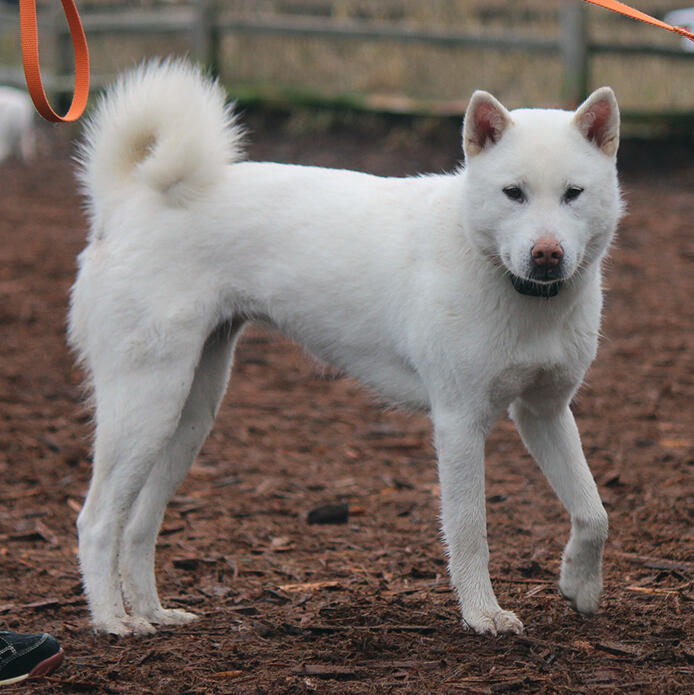
Club Officers & Board
| Position | Name | Direct Email |
|---|---|---|
| President | Kristina Arthmann | [email protected] |
| Vice President | Brittany Wall | [email protected] |
| Secretary | Lacee Curtis | [email protected] |
| Treasurer | Jason Arthmann | [email protected] |
| Education Coordinator | C.J. McCammon | [email protected] |
| Board Member | C.J. McCammon | [email protected] |
| Board Member | Tain Rose | unavailable |
| Board Member | Cass Yun | unavailable |
